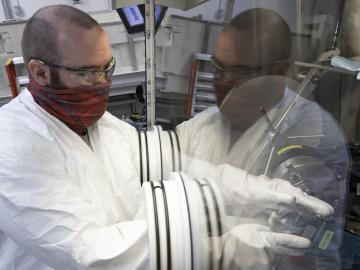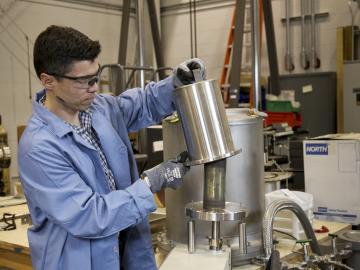
Filter News
Area of Research
- Advanced Manufacturing (2)
- Biology and Environment (30)
- Biology and Soft Matter (1)
- Computational Engineering (1)
- Computer Science (1)
- Energy Science (23)
- Fusion and Fission (18)
- Fusion Energy (11)
- Isotopes (20)
- Materials (22)
- Materials for Computing (2)
- Mathematics (1)
- National Security (14)
- Neutron Science (6)
- Nuclear Science and Technology (28)
- Nuclear Systems Modeling, Simulation and Validation (2)
- Quantum information Science (7)
- Supercomputing (45)
News Type
News Topics
- (-) Advanced Reactors (25)
- (-) Cybersecurity (17)
- (-) Exascale Computing (52)
- (-) Isotopes (38)
- (-) Nuclear Energy (85)
- (-) Quantum Science (58)
- (-) Space Exploration (23)
- 3-D Printing/Advanced Manufacturing (89)
- Artificial Intelligence (92)
- Big Data (62)
- Bioenergy (84)
- Biology (100)
- Biomedical (53)
- Biotechnology (28)
- Buildings (50)
- Chemical Sciences (48)
- Clean Water (30)
- Composites (21)
- Computer Science (153)
- Coronavirus (30)
- Critical Materials (17)
- Education (2)
- Emergency (4)
- Energy Storage (64)
- Environment (164)
- Fossil Energy (7)
- Frontier (45)
- Fusion (47)
- Grid (54)
- High-Performance Computing (93)
- Hydropower (12)
- Irradiation (2)
- ITER (7)
- Machine Learning (51)
- Materials (87)
- Materials Science (89)
- Mathematics (11)
- Mercury (10)
- Microelectronics (3)
- Microscopy (34)
- Molten Salt (7)
- Nanotechnology (29)
- National Security (63)
- Neutron Science (109)
- Partnerships (37)
- Physics (38)
- Polymers (18)
- Quantum Computing (39)
- Security (17)
- Simulation (51)
- Software (1)
- Statistics (3)
- Summit (48)
- Transportation (66)
Media Contacts

Oak Ridge National Laboratory scientists demonstrated that an electron microscope can be used to selectively remove carbon atoms from graphene’s atomically thin lattice and stitch transition-metal dopant atoms in their place.

To better understand the spread of SARS-CoV-2, the virus that causes COVID-19, Oak Ridge National Laboratory researchers have harnessed the power of supercomputers to accurately model the spike protein that binds the novel coronavirus to a human cell receptor.
A study by Oak Ridge National Laboratory, the University of Copenhagen, the National Park Service and the U.S. Geological Survey showed that hotter summers and permafrost loss are causing colder water to flow into Arctic streams, which could impact sensitive fish and other wildlife.

On Feb. 18, the world will be watching as NASA’s Perseverance rover makes its final descent into Jezero Crater on the surface of Mars. Mars 2020 is the first NASA mission that uses plutonium-238 produced at the Department of Energy’s Oak Ridge National Laboratory.

A better way of welding targets for Oak Ridge National Laboratory’s plutonium-238 production has sped up the process and improved consistency and efficiency. This advancement will ultimately benefit the lab’s goal to make enough Pu-238 – the isotope that powers NASA’s deep space missions – to yield 1.5 kilograms of plutonium oxide annually by 2026.

A new tool from Oak Ridge National Laboratory can help planners, emergency responders and scientists visualize how flood waters will spread for any scenario and terrain.

As program manager for the Department of Energy’s Oak Ridge National Laboratory’s Package Testing Program, Oscar Martinez enjoys finding and fixing technical issues.

Porter Bailey started and will end his 33-year career at ORNL in the same building: 7920 of the Radiochemical Engineering Development Center.

The INFUSE fusion program announced a second round of 2020 public-private partnership awards to accelerate fusion energy development.

East Tennessee occupies a special place in nuclear history. In 1943, the world’s first continuously operating reactor began operating on land that would become ORNL.


